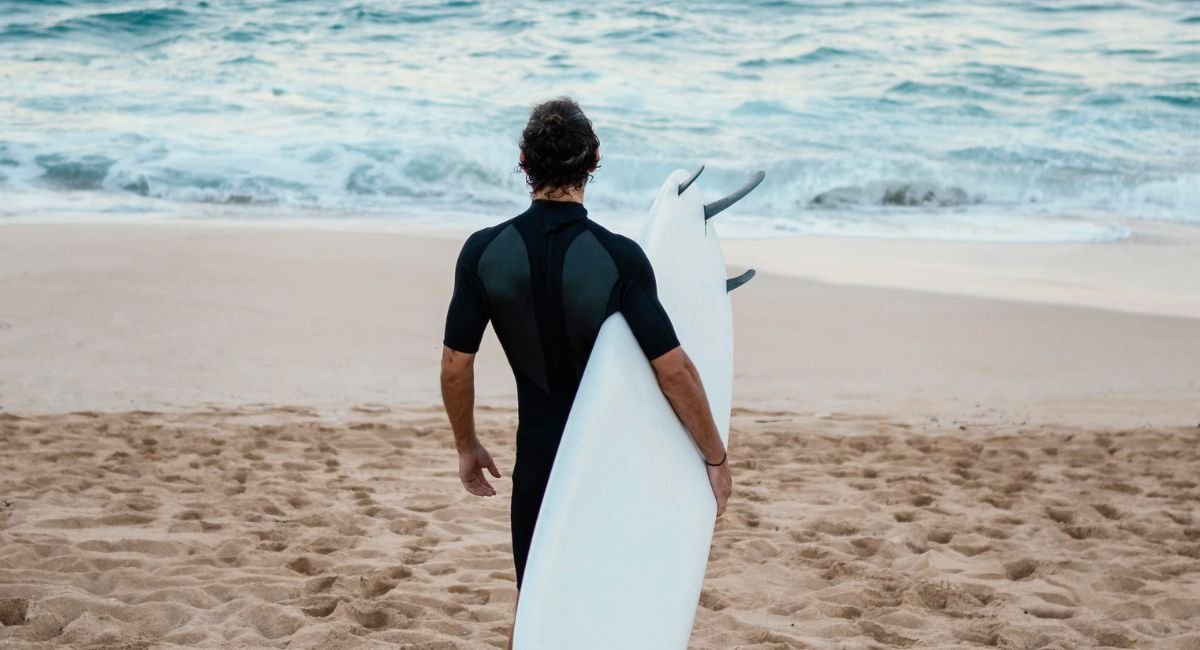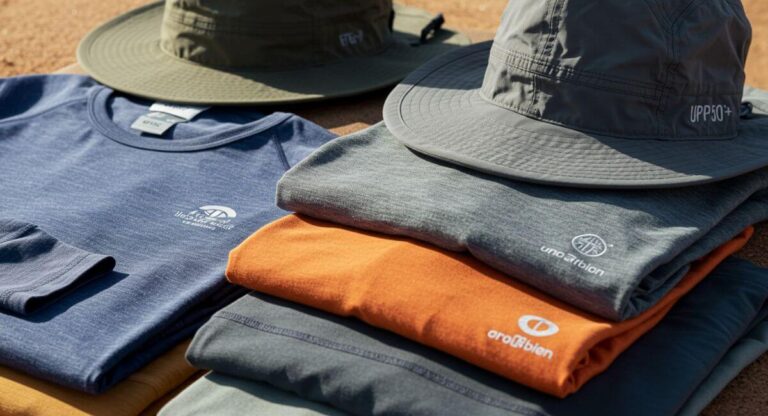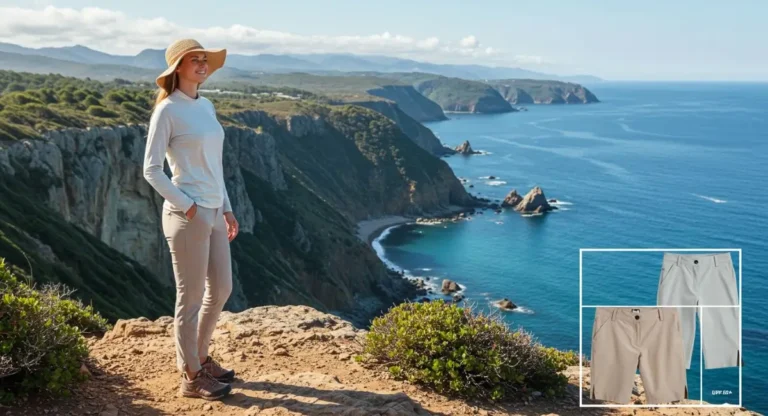Guide to Choosing the Best Sun Protection Clothing Swimwear
Table of Contents
Why Sun Protection Clothing Matters
Did you know that regular clothing typically only offers an Ultra Violet Protection Factor (UPF) of around 5, while specialized sun protection clothing swimwear can provide UPF 50+, blocking 98% of harmful UV rays? As someone who has battled with sensitive skin and experienced the painful aftermath of sun damage, I’ve learned that traditional sunscreen application isn’t always enough, especially when enjoying water activities.
Sun protection clothing swimwear has revolutionized how we can safely enjoy outdoor activities. Whether you’re a dedicated swimmer, a beach enthusiast, or simply looking to protect yourself and your family during outdoor adventures, investing in quality sun-protective swimwear can make all the difference between a memorable day and a painful sunburn experience.
In this comprehensive guide, I’ll share everything you need to know about sun protection clothing swimwear, from understanding UPF ratings to choosing the best materials and styles. I’ll also review some of the best options I’ve personally tested to help you make informed decisions for your sun safety needs.
Key Features of Quality Sun Protection Clothing Swimwear
When shopping for sun protection clothing swimwear, understanding the key features that make them effective is crucial. These aren’t just ordinary swimsuits with fancy marketing—they incorporate specific technologies and design elements that provide genuine protection against harmful UV radiation.
UPF Rating System Explained
The most important feature of sun protection clothing swimwear is its UPF (Ultraviolet Protection Factor) rating. Similar to how SPF works for sunscreen, UPF indicates how effectively a fabric blocks ultraviolet radiation:
- UPF 15-20: Blocks 93.3-95.9% of UV radiation
- UPF 25-35: Blocks 96.0-97.4% of UV radiation
- UPF 40-50+: Blocks 97.5-98%+ of UV radiation
For maximum protection, look for sun protection clothing swimwear with UPF 50+, which blocks 98% or more of both UVA and UVB rays.
Fabric Technology and Innovation
The best sun protection clothing swimwear utilizes advanced fabric technologies:
- Tightly Woven Synthetics: Materials like nylon and polyester with tight weaves naturally block more UV radiation
- Specialized Treatments: Many fabrics are treated with UV-absorbing compounds that enhance protection
- Moisture-Wicking Properties: Quality sun protective swimwear often includes moisture management to keep you comfortable
- Chlorine and Saltwater Resistance: Durability features ensure the UV protection doesn’t degrade after repeated exposure to pool chemicals or ocean water
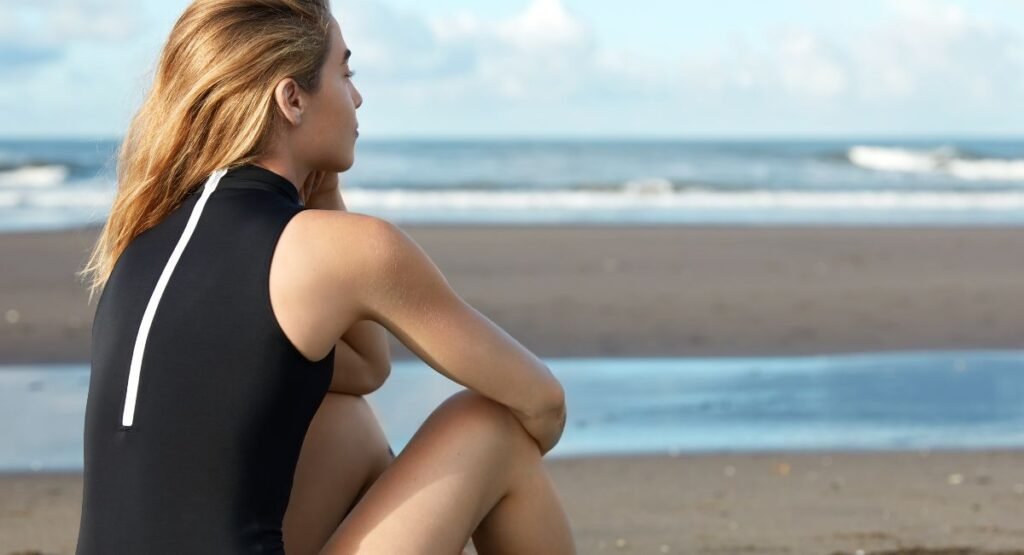
Coverage Considerations
Effective sun protection clothing swimwear often provides more coverage than traditional swimwear:
- Long-sleeve rash guards and swim shirts protect the arms and torso
- High-neck designs shield the often-forgotten chest and neck areas
- Swim leggings or longer shorts offer protection for the legs
- Full-body suits provide comprehensive coverage for maximum protection
How Sun Protection Clothing Swimwear Works
Understanding the science behind sun protection clothing swimwear can help you make better purchasing decisions and use these garments effectively.
The Science of UV Protection in Fabrics
Sun protection clothing swimwear works through a combination of physical barriers and chemical treatments:
- Physical Barrier: The tight weave of specialized fabrics creates a physical barrier that prevents UV radiation from reaching your skin. Darker colors and denser weaves typically offer better protection.
- UV-Absorbing Treatments: Many sun protection clothing swimwear items are treated with UV-absorbing chemicals or have special additives woven into the fabric. These compounds absorb UV radiation before it can reach your skin.
- Reflective Properties: Some advanced fabrics include reflective properties that bounce UV rays away from the body.
According to dermatologists from the Skin Cancer Foundation, wearing sun protection clothing swimwear is actually more effective than sunscreen alone because it provides consistent protection that doesn’t need to be reapplied and can’t be washed off in water.
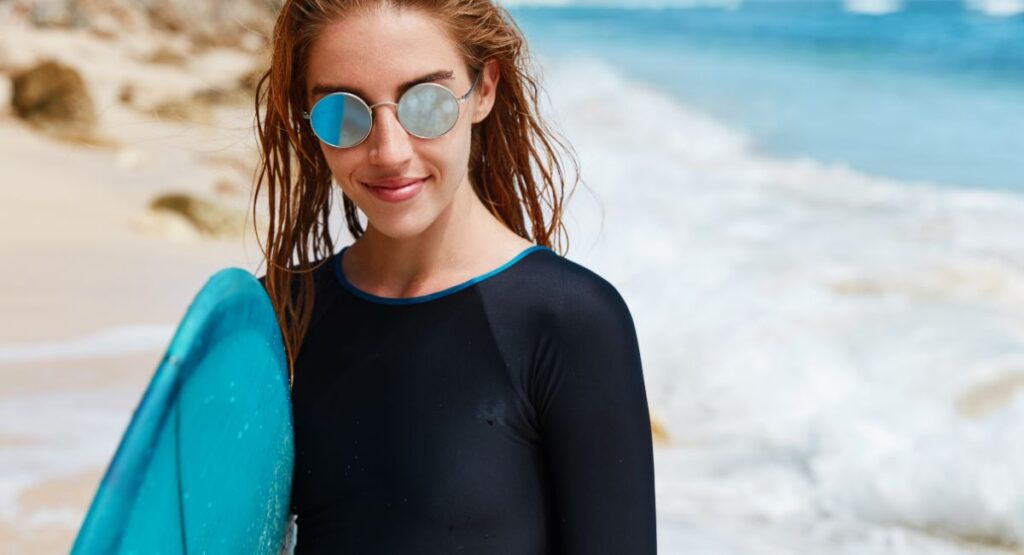
Comparing with Traditional Sun Protection Methods
When compared to traditional sun protection methods, sun protection clothing swimwear offers several advantages:
| Protection Method | Pros | Cons |
|---|---|---|
| Sun Protection Clothing Swimwear | – Consistent protection<br>- No reapplication needed<br>- Water-resistant protection<br>- Environmentally friendly | – Initial cost can be higher<br>- Limited style options<br>- May be warmer than regular swimwear |
| Traditional Sunscreen | – Can be applied anywhere<br>- Various SPF options<br>- Affordable initial cost | – Requires frequent reapplication<br>- Can wash off in water<br>- May contain chemicals harmful to marine life<br>- Easy to miss spots |
| Regular Swimwear | – More style options<br>- Generally less expensive<br>- Often lighter weight | – Minimal UV protection<br>- Exposes more skin to sun damage<br>- May fade from sun exposure |
Dr. Elizabeth Hale, a dermatologist and senior vice president of the Skin Cancer Foundation, notes that “Clothing is the first line of defense against the sun’s harmful rays and is one of the most effective forms of protection.”
Benefits and Drawbacks of Sun Protection Clothing Swimwear
The Advantages
- Superior Protection: Sun protection clothing swimwear with UPF 50+ blocks 98% of harmful UV rays, significantly reducing your risk of sunburn, premature aging, and skin cancer.
- Convenience: Unlike sunscreen that requires reapplication every 2 hours (or sooner if swimming), sun protection clothing swimwear provides continuous protection without the need for reapplication.
- Cost-Effective Long-Term: While the initial investment may be higher than regular swimwear, you’ll save money on sunscreen over time and potentially on medical bills related to sun damage.
- Eco-Friendly Option: Reduces the amount of chemical sunscreen entering our oceans and waterways, which can harm coral reefs and marine life.
- Versatility: Many sun protection clothing swimwear items can be worn both in and out of the water, making them perfect for all-day beach or pool outings.
The Drawbacks
- Higher Initial Cost: Quality sun protection clothing swimwear typically costs more than traditional swimwear, with prices ranging from $30-$100+ per piece.
- Style Limitations: Though improving rapidly, the style options for sun protection clothing swimwear may still be more limited than conventional swimwear.
- Potential for Overheating: Full-coverage sun protection clothing swimwear may feel warmer than minimal swimwear in very hot conditions, though many modern fabrics are designed to be cooling.
- Fit Challenges: Finding the perfect fit is crucial for comfort and protection, and may require more trial and error than with standard swimwear.
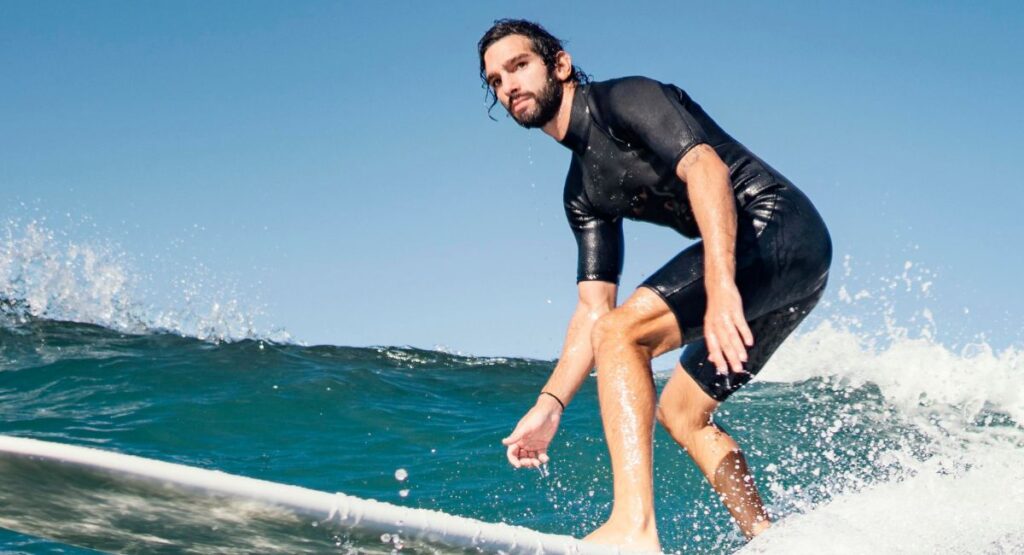
Step-by-Step Guide to Choosing the Right Sun Protection Clothing Swimwear
Step 1: Determine Your Protection Needs
Consider your skin sensitivity, activities, and exposure time:
- Very fair skin or history of skin cancer? Prioritize maximum coverage and UPF 50+
- Planning long days of surfing or snorkeling? Look for durable, full-coverage options
- Brief swimming sessions with moderate sun exposure? A UPF 50+ swim shirt might suffice
Step 2: Select the Right UPF Rating
While any UPF rating provides some protection, for swimming and extended outdoor activities, aim for:
- Minimum: UPF 30 (blocks ~96% of UV radiation)
- Recommended: UPF 50+ (blocks 98%+ of UV radiation)
Step 3: Choose Appropriate Coverage
Match your coverage to your needs and comfort level:
- Full Body: Maximum protection with full-body suits or combining pieces
- Upper Body Focus: Rash guards, swim shirts, and high-neck designs
- Lower Body Protection: Swim leggings, board shorts, or swim skirts with UPF protection
Step 4: Consider Material and Comfort
Look for these qualities in your sun protection clothing swimwear:
- Chlorine/saltwater resistance for durability
- Quick-drying properties
- Moisture-wicking capability for comfort
- Stretch and flexibility for movement
- Lightweight fabric that doesn’t feel heavy when wet
Step 5: Verify Sizing and Fit
Sun protection clothing swimwear should be:
- Snug but not restrictive
- Free from areas that stretch too thin when worn (which reduces protection)
- Comfortable for your planned activities
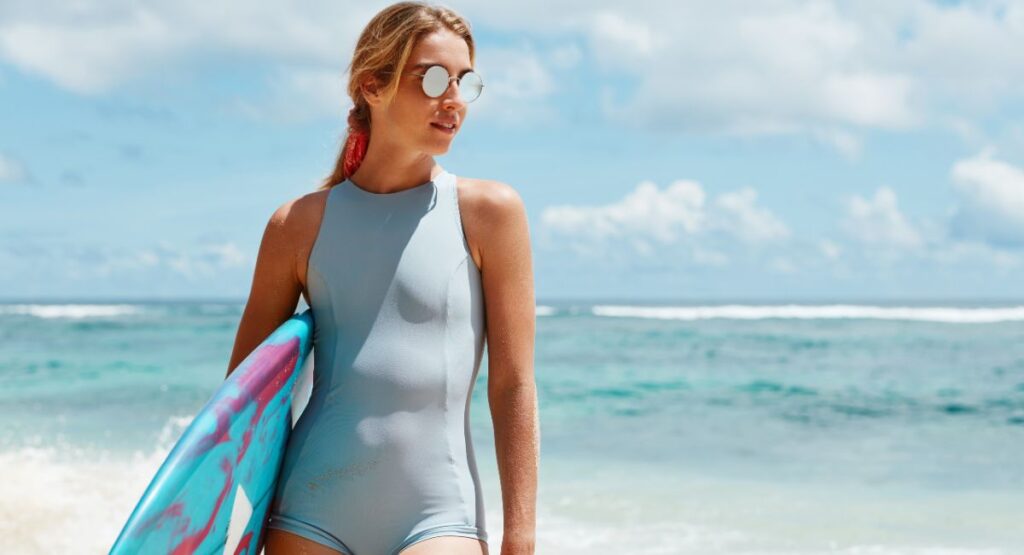
My Top Recommended Sun Protection Clothing Swimwear
After years of testing various brands and styles, here are some of the best sun protection clothing swimwear options I’ve tried:
Best Overall Rash Guards
O’Neill Men’s Basic Skins UPF 50+ Long Sleeve Rash Guard
For men, this O’Neill rash guard offers exceptional sun protection with minimal bulk. It features flat-seam construction to prevent chafing and a four-way stretch fabric that moves with you. After multiple washing cycles, the UPF protection has held up exceptionally well.
Price: $35
Best Full Coverage Options
Speedo Women’s Swimsuit Bottom Jammer Mid Length
These swim leggings offer UPF 50+ protection while being surprisingly comfortable for swimming. They don’t restrict movement and stay in place without rolling down. Paired with a rash guard, they provide nearly complete lower body protection.
Price : $39
TSLA Men’s Swim Trunks, Quick Dry Swimming Beach Board Shorts, Lightweight Swimwear
These longer-length swim trunks offer excellent thigh protection without looking overly technical. The built-in liner provides comfort, and the quick-dry fabric performs impressively. They look like regular board shorts but offer serious sun protection.
Price : $ 22
Best for Kids
SwimZip UPF 50+ Long Sleeve Rash Guard for Boys’ and Girls’ – Baby, Toddler, Kids
If you have little ones, this one-piece sunsuit provides full torso and arm coverage with UPF 50+ protection. The full zipper makes it easy to put on and take off, even when wet—a lifesaver with squirmy kids! The suits are adorable, comfortable, and offer excellent protection.
Price range: $24
Best Budget-Friendly Option
Kanu Surf Boys & Girls’ Platinum Long-Sleeve Rashguard
These affordable rash guards for the whole family offer solid UPF 50+ protection at a lower price point. While they may not last as many seasons as premium brands, they provide excellent protection and come in a wide range of colors and sizes.
For boys, Please Chec kHere
For Girls, Please Check Here
Price range: $15-19
Real-World Scenarios for Using Sun Protection Clothing Swimwear
Beach Vacations
For a week-long beach vacation, I recommend bringing:
- 2 UPF 50+ rash guards or swim shirts
- 1-2 pairs of UPF swim leggings or longer swim shorts
- A wide-brimmed hat and sunglasses for additional protection
- Sunscreen for exposed areas
This combination allows you to enjoy extended time in the water without worrying about reapplying sunscreen constantly. I rotate between rash guards to allow them to fully dry between uses.
Pool Days with Kids
If you’re managing pool days with children:
- Dress kids in full-coverage sunsuits with zippers for easy bathroom breaks
- Have them wear swim hats with neck flaps for additional protection
- Use swim shirts yourself so you can focus on the kids rather than reapplying sunscreen
- Set up a shade tent or umbrella for breaks from the sun
Water Sports and Activities
For activities like surfing, paddleboarding, or snorkeling:
- Wear a long-sleeve rash guard with high neck protection
- Choose swim leggings or longer board shorts
- Consider swim gloves and a hood for surfing in highly reflective conditions
- Apply sunscreen to your face, ears, and any other exposed areas
During a recent snorkeling trip, my sun protection clothing swimwear saved me from what would have been a severe back sunburn, as I was face-down in the water for hours admiring coral reefs.
Common Mistakes to Avoid When Using Sun Protection Clothing Swimwear
Mistake #1: Relying Solely on Sun Protection Clothing Without Sunscreen
While sun protection clothing swimwear blocks most UV rays, you still need sunscreen on exposed areas like your face, hands, and feet. Use a water-resistant, broad-spectrum sunscreen with at least SPF 30 on uncovered areas.
Mistake #2: Choosing the Wrong Fit
Overly tight sun protection clothing will stretch the fabric thin, reducing its UPF effectiveness. Too loose, and it can bunch uncomfortably or ride up in the water. Follow size guides carefully and consider that some items may fit differently when wet.
Mistake #3: Ignoring Care Instructions
Improper washing and care can degrade the UV protection properties of your swimwear. Common care mistakes include:
- Using bleach or harsh detergents
- Putting items in the dryer on high heat
- Not rinsing chlorine or salt water promptly after use
Mistake #4: Forgetting About Reflected UV Radiation
Sand, water, and concrete around pools can reflect UV radiation upward, potentially reaching skin under the brim of hats or chin areas. Choose sun protection clothing swimwear that accounts for these reflection angles.
Mistake #5: Not Replacing Worn Items
Sun protection clothing swimwear doesn’t last forever. If you can see light through the fabric when stretched, or if it has become thin and faded, its UV protection capabilities have likely diminished. Most quality items should last 1-3 seasons of regular use before needing replacement.
Maintenance and Longevity Tips for Sun Protection Clothing Swimwear
To keep your sun protection clothing swimwear performing at its best:
Proper Washing Techniques
- Rinse in fresh water immediately after swimming in chlorinated pools or salt water
- Hand wash with mild soap or use a gentle cycle with cold water
- Avoid fabric softeners, which can clog fibers and reduce moisture-wicking properties
- Use specialized detergents for technical fabrics when possible
Storage Best Practices
- Dry completely before storing to prevent mildew growth
- Store away from direct sunlight, which can fade colors and degrade UV protection
- Avoid folding in the same place repeatedly to prevent permanent creases that can weaken fabric
Extending the Life of Your Sun Protection Swimwear
- Rotate between multiple pieces to reduce wear on any single item
- When sitting on rough surfaces like pool decks or rocks, sit on a towel to prevent abrasion
- After a season of use, test the UPF by holding the fabric up to bright light—if you can easily see through it, it’s time for a replacement
Revitalizing UV Protection
Some sun protection clothing swimwear can be treated with special UPF-enhancing laundry additives like SunGuard, which can restore some protection to aging garments. However, these treatments typically last only about 20 washes.
Conclusion: Embracing Sun-Safe Swimming
Sun protection clothing swimwear represents one of the most effective ways to enjoy water activities while minimizing dangerous UV exposure. From rash guards and swim shirts to full-coverage options, these specially designed garments offer consistent, reliable protection that doesn’t wash off or require constant reapplication.
When choosing sun protection clothing swimwear, prioritize UPF 50+ ratings, appropriate coverage for your activities, and comfortable, durable materials. Remember that even the best sun protective swimwear should be part of a comprehensive sun safety strategy that includes seeking shade, wearing hats and sunglasses, and using sunscreen on exposed skin.
By investing in quality sun protection clothing swimwear and caring for it properly, you can enjoy your favorite water activities with peace of mind, knowing you’re taking significant steps to protect your skin from damaging UV radiation. Your future self will thank you for the protective measures you take today.
Have you tried sun protection clothing swimwear? Do you have favorite brands or styles to recommend? Share your experiences in the comments below!
Frequently Asked Questions
What clothing material is best for sun protection?
Tightly woven synthetic fabrics like nylon and polyester with special UV-inhibiting treatments typically offer the best sun protection with UPF 50+ ratings.
Does UV swimwear work?
Yes, properly rated UPF swimwear effectively blocks up to 98% of harmful UVA and UVB rays, providing consistent protection that doesn’t wash off in water.
What is the best material to protect you from the sun while you swim?
Nylon-elastane blends with UPF 50+ ratings provide excellent sun protection while offering the stretch and quick-drying properties ideal for swimming.
Do tan through swimwear actually work?
Yes, tan-through swimwear works by allowing some UV rays to penetrate the fabric, but this significantly reduces its sun protection properties and increases skin damage risk.

